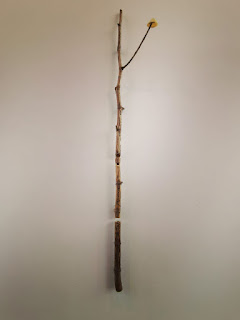
Responding to this year's theme, “Irish Folklore and Fairy Tales” of Skibbereen’s St. Patrick’s Parade, artists Ana Ospina, Alice Halliday and Michael Stephens were commissioned by West Cork Arts Centre and awarded a funded residency at Uillinn from 13 January to 21 March, in partnership with Skibbereen Chamber of Commerce and Cork County Council. Together, the three artists created an engaging and explorative approach towards Irish mythology, inviting the staff of Field’s Supervalue as well as members of Skibbereen’s community to participate. Over the last two months many workshops took place at Uillinn West Cork Arts Centre at which people came together, creating and crafting beautiful costumes to add on to the parade.
But wait a second. Folklore and Fairy-tales. St. Patrick was Christian, wasn’t he? Christianity and Paganism, how does this work? These were my thoughts when I heard of this year's theme for St. Patrick’s Day.
Irish Folklore dates back millennia, Ana told me, transmitted orally, shaped and changed over time. Only since the Christians arrived in Ireland, the stories were written down - by monks, ironically. Some of the pagan gods and heroes were adopted as saints by Christianity, similar to the Romans adopting Greek Mythology.

|
| Artist Alice as Brigid |
One great example for that is Saint Brigid. In pre-Ireland she was the great Goddess of spring season, fertility, healing, poetry and smithcraft. According to Cormac’s Glossary (that’s the one monks wrote when they arrived in Ireland in the 10th century) Brigid, Goddess of Poetry had two sisters: Brigid the Healer and Brigid the Smith - a triple deity? That sounds very similar to the Christian triple deity of God, if you ask me.
However, in Christianity there is only one God. Luckily, the old Christian monks did not simply wipe out all the old Irish gods and forced people to believe in something completely different, like it sadly happened during colonisation so many times. Forcing people to ignore and forget their cultural heritage is not what the monks had in mind. Instead, they were more considerate and allowed these old Gods a place as Saints in the new Christian world. Arguably, that is how Brigid became a Saint, too. This way, Brigid is kept alive and can be worshipped until this very day. When I researched this, I couldn’t help but be amazed by how respectful of each other's culture people were back then, compared to what I know about colonisation. Religions were merged rather than one forcefully substituted by the other. And I think I better understand now, why this Christian holiday celebrates folklore and fairy-tales: as a reminder of Ireland’s cultural roots, which certainly have a place in today’s Christianity.

|
| Head Pieces for Main Characters |
So let’s get back to the artists in residence at Uillinn, Ana, Alice and Michael who have put so much work and energy into this great project. Many workshops have taken place, and even in times of COVID-19 and the cancellation of parades planned for 17 March, the creative team continued building beehives, sewing costumes, painting masks, crafting bluebells and grain ears and so much more - and they never have stopped smiling and keeping a positive attitude towards the situation, always welcoming those of the community who wanted to contribute while respecting the new social distancing and hand washing directives as they began to role in.
| Costume Draping | Bee Hive in the Making |
| Artist Ana making Bluebells | Stitching Flowers |
At the heart of their creative vision are main characters based on traditional Irish folklore - Puca in the shape of a fox, the mermaid, Goddess Brigid, the Green Man and Gobnait, queen of bees - which will be supported by minor characters and surrounded by spectacular props during the parade.
There have been positive responses from so many people, keeping spirits up during these difficult times. Thanks to the artists’ great stamina and the community's engaging work, we can all look forward to finally seeing the colourful outcome of the project. Once the situation allows, the costumes will be staged in an on location photo shoot, the results of which will then be displayed in a virtually for us all to see. For a live experience we can happily await next year's St. Patrick’s Day, where the costumes are likely to be paraded. Until then, stay healthy!











